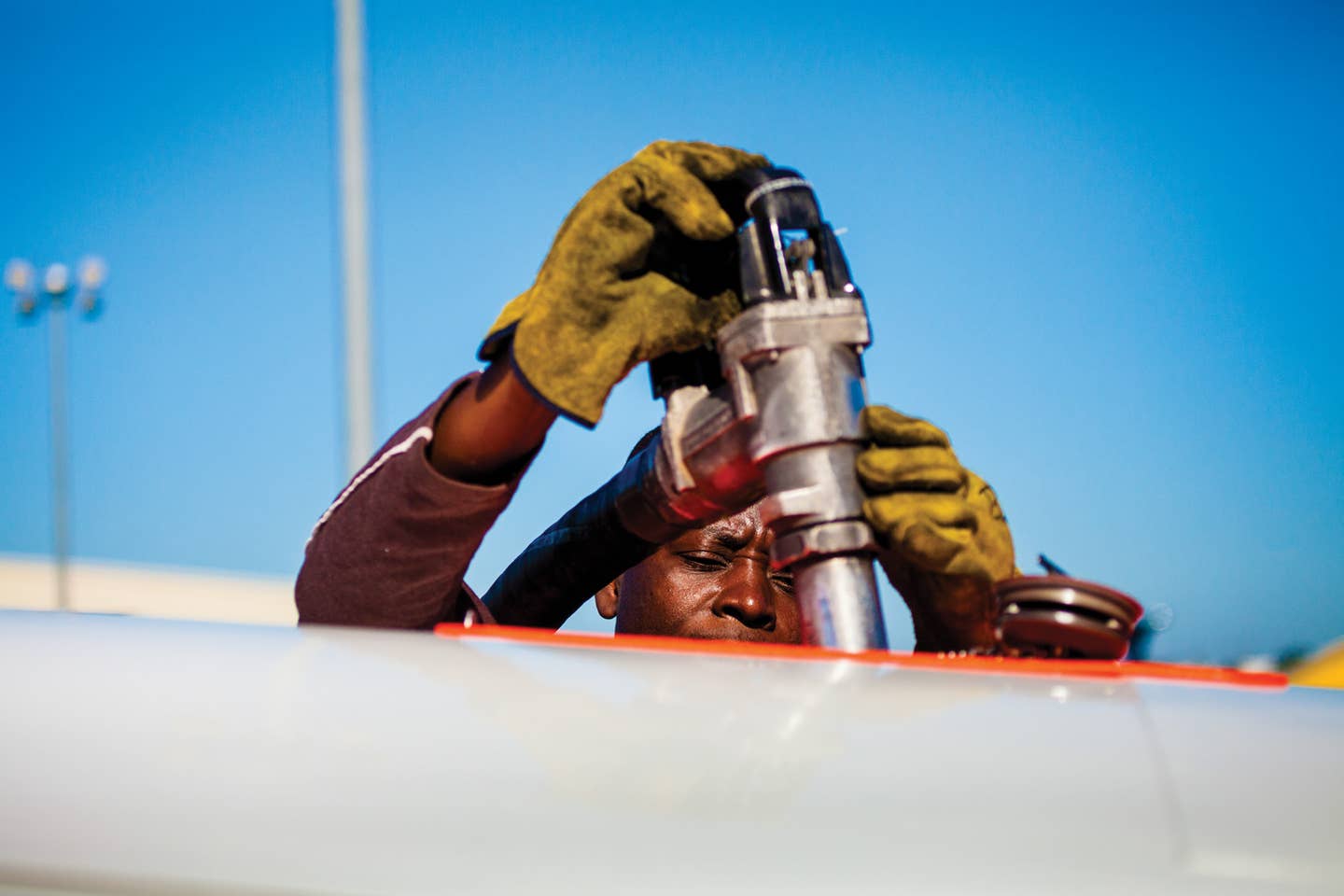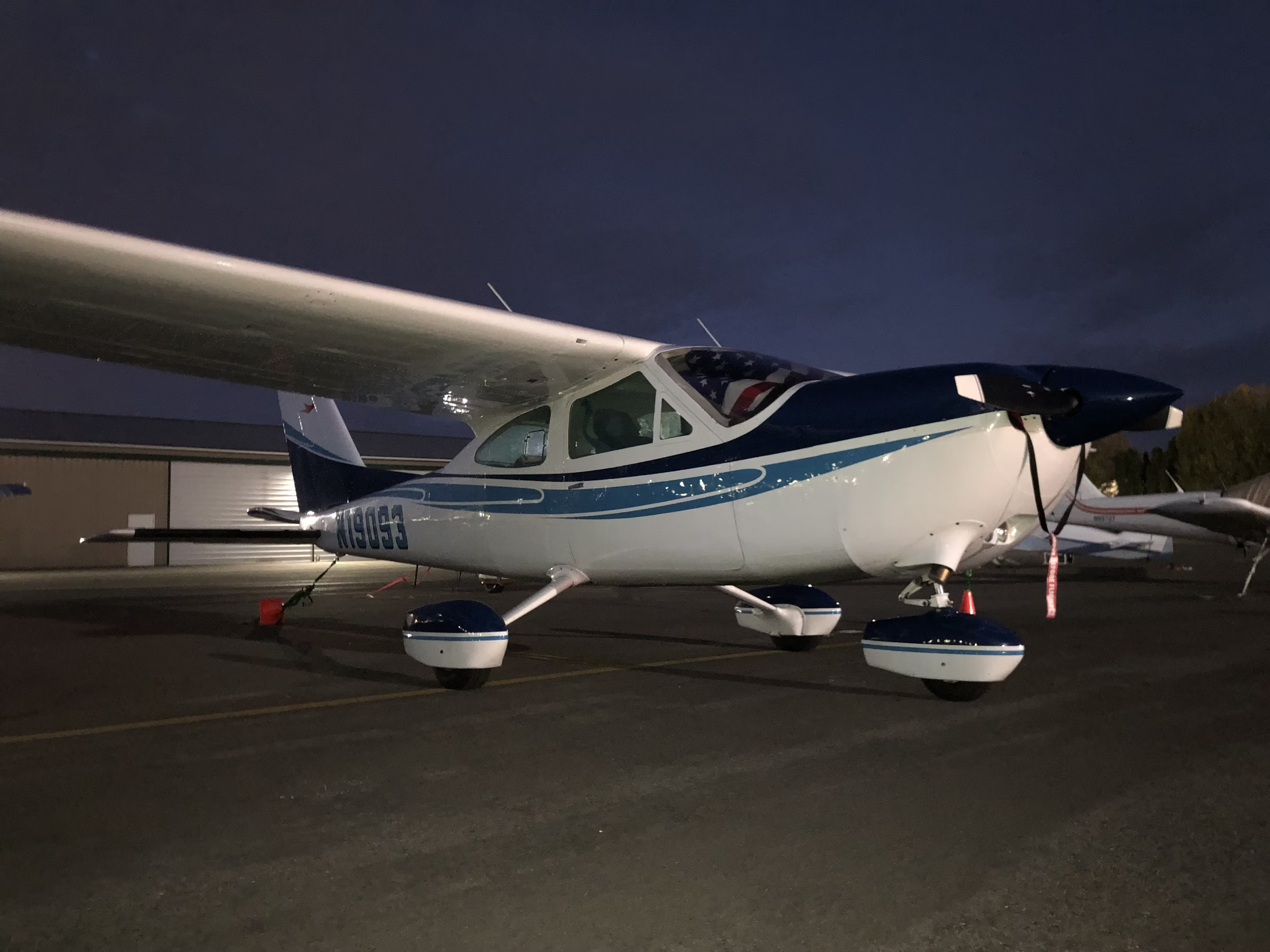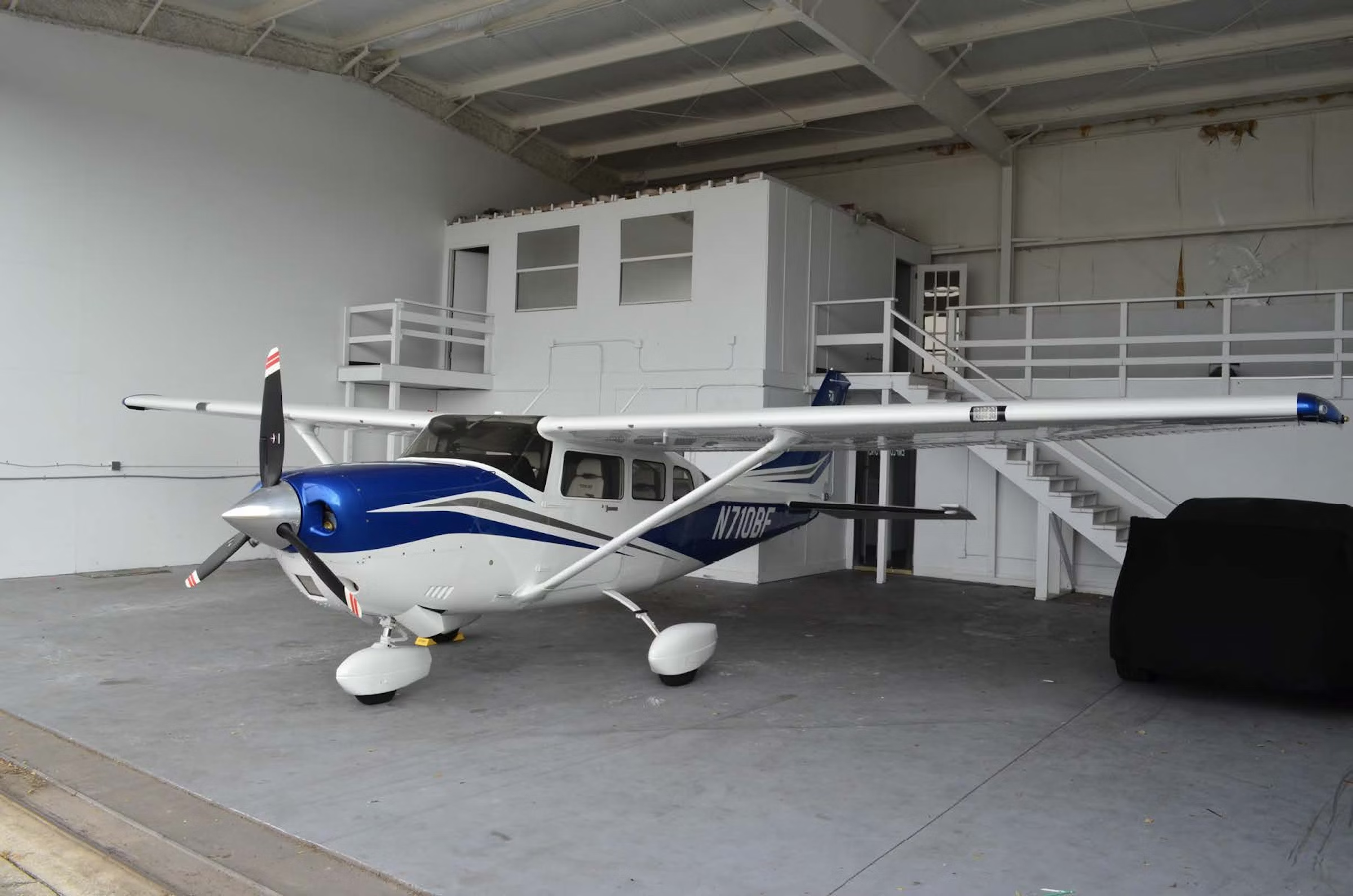
Unleaded fuel should improve piston-engine operating efficiency. Jon Whittle
The dangers posed by lead’s carcinogenic toxicity, whether it’s inhaled or absorbed into the bloodstream, have been well-known for decades. Lead is particularly harmful to children during their developmental years. The U.S. Environmental Protection Agency began discussing a total ban on lead in automobile gasoline back in the mid-1980s and outlawed the heavy metal in all fuel sold in the United States nearly 25 years ago, with one exception: aviation gasoline, or avgas.
General aviation’s need for a high-octane fuel to power high-compression piston engines required avgas makers to add tetraethyl lead before delivery to prevent damaging engine knock, or detonation, that could result in engine damage. The higher the octane rating, the better the chances the fuel can be compressed without detonation. The FAA recently estimated that nearly 170,000 aircraft operate today on 100 low lead (LL) fuel, burning 150 to 175 million gallons annually.
Tim Roehl, president of Ada, Oklahoma-based GAMI, a company that is creating an unleaded aviation fuel, says that’s about “one-tenth of 1 percent of what the fuel companies sell for automobiles, a tiny part of their revenue,” and it highlights why big fuel companies might have little motivation to alter their businesses to solve the problem.
The FAA clearly realizes that avgas emissions have become the largest contributor to the relatively low levels of lead emissions produced in the United States. An FAA unleaded avgas transition aviation rule-making committee (UAT ARC) found in 2012 that "petitions and potential litigation from environmental organizations regarding lead-containing avgas have called for the U.S. Environmental Protection Agency to consider regulatory actions to eliminate or reduce lead emissions from aircraft." In 2010, the EPA published an advanced notice of proposed rulemaking against piston-engine powerplants using leaded avgas, although no action was immediately taken. The temporary reprieve for 100LL apparently occurred after the FAA agreed to begin the search for an alternative fuel, although the agency acknowledged a hurdle to the process. "No market-driven reason exists to move to a replacement fuel due to the limited size of the avgas market, diminishing demand, the specialty nature of avgas, [and the] safety, liability and the investment expense involved in a comprehensive approval and deployment process."
Swift Fuel's CEO, Chris D'Acosta, says the company introduced UL94 aviation gasoline "because as leaders in pursuit of a 100-octane unleaded solution, we knew it was going to be challenging, and we also knew that many pilots were under the perception the EPA was forcing them into the change. It doesn't all need to boil down to a government mandate. We want to educate pilots on the merits of unleaded fuel—no spark-plug fouling, no lead corrosion in the oil system, less frequent maintenance and lower toxicity."
GAMI’s Roehl notes that “burning an unleaded fuel is just much easier on the engine. The impact of lead and its scavenging agent in the fuel are what cause problems with valves too.” He explains why GAMI has been involved for years searching for the right unleaded fuel formula. “We do a lot of things for the good of GA. That’s just the nature of our company. But we also have the ability to test octane performance in engines onsite. We have some unique industry knowledge about how to adopt an unleaded high-octane fuel, and we want to get the industry to recognize the impact of the problem.” When cars transitioned away from leaded fuels, he says, the interval for tuneups increased from every 15,000 miles to every 60,000 miles or more, not to mention longer intervals between oil changes. GA will benefit from those same advantages, he predicts.
Where the Work Began
The 100LL replacement effort started with the establishment of the UAT ARC that eventually led to the formation of the collaborative piston aviation fuels initiative (PAFI) in 2014. PAFI’s mission is “to evaluate candidate unleaded replacement fuels and identify those best able to technically satisfy the needs of the existing aircraft fleet, while also considering the production, distribution, cost, availability [and] environmental and health impacts of those fuels.” The FAA believes PAFI is the most viable path to a fleetwide approval of a new fuel formulation, one that will cause the least amount of havoc on the existing piston-engine fleet and, above all, will be a safe alternative to leaded avgas. Once a fuel is chosen, individual aircraft would require a supplemental type certificate (STC) to complete the transition.
PAFI members include the FAA as well as AOPA, EAA, the National Business Aviation Association, National Air Transportation Association and General Aviation Manufacturers Association, leaving aviation fuel and engine manufacturers somewhat peripherally involved. Little news about the transition process flows from the FAA because the agency is bound by proprietary agreements that tie everyone's hands. When Shell was asked about its progress on a new fuel formula, for instance, a company spokesman referred Flying to the FAA website on the avgas initiative where the agency publishes all updates. Other companies outside of PAFI are also searching for an alternative fuel, including Phillips 66 and GAMI. So far a replacement fuel that the FAA can approve for the entire GA fleet has yet to be identified.
PAFI's initial search for an unleaded replacement fuel ended with 17 possibilities that the group eventually pared down to just two, one from Shell and another from Swift Fuels. Last fall the FAA's office of alternative fuels discovered unspecified problems with both fuels and planned to take a research break to give both companies an opportunity to rethink their formulas.
At that point, Swift voluntarily removed itself from the PAFI competition, preferring to carry on with efforts to certify its own UL102 unleaded fuel by working privately with the FAA and OEMs. Swift already sells UL94 in some regions of the country, and has to date completed a variety of engine performance tests on its UL102 gasoline formulation in collaboration with engine manufacturers and at the FAA’s aviation fuels and engine test facility at the Technical Center in Atlantic City, New Jersey.
Swift’s D’Acosta says: “We’re making, selling and marketing our own UL94 avgas that can power two-thirds of the current U.S. piston fleet, about 110,000 aircraft. We sell UL94 because we’re in pursuit of the high-octane solution, and we want people to know that Swift is looking for the industrywide replacement for 100LL, the whole enchilada. We see UL94 as a stepping stone to that solution.”
Tim Roehl says GAMI “has been flying under the radar for years” with efforts that began before PAFI, but the company is now “sneaking up on our first unleaded fuel certification.” GAMI is blessed with significant in-house testing capabilities that are comparable to the FAA’s Atlantic City facility. Both Swift and GAMI say they believe working unencumbered by PAFI will bring an unleaded fuel to the marketplace faster.
Continental Aerospace Technologies (formerly Continental Motors) associate vice president of engineering Chris Pollitt mentioned another hurdle to the creation of a new unleaded fuel formula: “The new fuel must deliver exactly the same performance as 100LL with zero adjustments.” Most engines can be adjusted to accommodate changes to fuel characteristics or performance limits, meaning the vast majority of engines could easily be adapted to run on a fuel with slightly different properties. “The requirement for 100 percent backward compatibility with zero adjustments is a significant limitation, and it is at the core of PAFI’s stalemate,” Pollitt says.
Instead of Lead, What?
Without the lead, avgas’ octane rating naturally works out to be 94, meaning some kind of nontoxic additive must be blended in to pump up the octane to at least 100. Phillips 66 says it plans to use a manganese-based additive invented in the late 1950s known to provide engine benefits such as octane increase, detonation protection, valve-seat recession and combustion improvement. Phillips 66 says manganese represents no threat to humans because “it’s an essential element to the body and is regulated through normal processes. It is also naturally occurring in the environment, and is abundant in the soil, the food we eat and the water we drink.”
Swift has spent six years developing an unleaded fuel. D’Acosta says: “In developing UL94, we used an all-hydrocarbon fuel with no special octane boosters. It’s 100LL without the lead. We had about a dozen fuel formulations tested at the FAA Tech Center over the past 10 years and work closely with the engine manufacturers in testing our fuels to ASTM international specifications.” The worry for all GA pilots, of course, is that solving the environmental lead problem might create $15 a gallon fuel. “No one is going to produce a solution that is not commercially competitive in a general sense with 100LL,” D’ Acosta says. “Nobody would buy it.”
Few companies are more tuned into the extra wear created on powerplants than the manufacturers. Continental’s application’s engineering manager Tim Kenny is hopeful for a solution. “We’re 98 percent of the way to where we need to be at this point,” he says.
And, of course, there’s the need to create minimal havoc across the GA fleet. Continental says it’s committed to doing the best it can to keep all engines running. But what if the current PAFI testing finds, in the end, that servicing only three-quarters of the current fleet is the best possible answer?
Lycoming believes leaving some aircraft owners high and dry is just one problem according to a report on the company’s website. “If our workhorse-aircraft demand goes away, we will all suffer higher costs and reduced FBO service levels. But not all aircraft and engines need 100-octane. It’s the parameters beyond octane that enable us to achieve airworthiness for the specified aircraft-operating envelopes today. The fleet that we fly today is about 50 times larger than annual new aircraft production and is based on technology designed around avgas. We cannot abandon the existing fleet.”
Production and distribution of a new unleaded fuel could also pose a challenge.
Roehl says he believes GAMI has found a way around this issue. “Our fuel—called G100UL—can be produced both by current fuel producers in the industry or a specialty chemistry processing industry. To help ensure it’s cost competitive, we want to take advantage of the current distribution systems in place. If we create anything new, it will get expensive.”
Swift Fuels aviation gasoline is produced only in Indiana, which means trucking is currently the only way to bring the product to other parts of the United States. “If we needed to produce significantly larger quantities, we could engage larger oil companies to do this work for us, using our proprietary formula,” D’Acosta says, “but they charge premium rates to do this in small quantities. Of course, no matter which company produces an unleaded 100-octane fuel, it must still pass FAA muster.
“We can’t do anything in this space without the FAA,” D’Acosta adds. “They’ve been working hard trying to lay out a post-2018 PAFI plan, but they’ve had plenty on their plate. It’s a big organization with a lot of regulations, and finding a 100LL replacement is a big, complicated undertaking. I think the EPA is waiting for the FAA to establish a workable unleaded avgas solution, because no one wants to halt 100LL production unless there is a viable fleetwide answer.”
The Future for Now
The FAA said recently that Shell had been working on mitigations to its first attempt and has provided an optimized fuel. Preliminary start-up testing has begun at the William J. Hughes Technical Center and an update to the PAFI website is coming soon. The EPA is currently evaluating the impact of lead emissions from aircraft using leaded aviation fuel and is completing two technical reports expected to be released later this year. Peter White, the FAA’s PAFI co-lead, explains: “The FAA will create a fleetwide authorization to operate on these fuels. Then it’s up to the market to transition and get those fuels into use.” But White also believes it will probably take a regulatory driver, such as a nudge from the EPA, to force a transition to an unleaded fuel. Stay tuned.
The Price of Jet-A Set to Rise in 2020?
New environmental laws aimed at reducing sulfur-oxide emissions produced by the global shipping industry could cause a spike in the price of jet fuel as the maritime industry moves away from “bottom of the barrel” heavy fuel oils to lower sulfur distillate fuels that are more similar to diesel, kerosene and jet-A.
And the change is coming quickly: On Jan. 1, 2020, the International Maritime Organization will implement a cap on global sulfur emissions for marine fuels, causing many ship operators to switch from the high-sulfur bunker fuel oil they use today to more environmentally friendly fuels, such as marine gas oil and very low-sulfur fuel oil.
Ship operators can also opt to install scrubbers on board to remove sulfur from heavy fuel or convert ships to burning liquid natural gas, but both these options are more expensive and difficult than simply switching to a low-sulfur fuel.
Therein lies the potential worry for operators of turbine aircraft (and owners of diesel vehicles) as refiners struggle to meet the massive production demand for low-sulfur maritime fuel.
As the IMO 2020 rule causes ship operators to abandon heavy fuels in favor of distillate fuels (which constitute diesel and jet-A), prices are expected to rise sharply, and immediately. The U.S. Energy Information Administration has predicted a rise of 65 cents per gallon for diesel after Jan. 1, 2020.
Nobody knows for sure what will happen with the price of jet-A, but recent derivative contracts for future fuel production seem to support the notion that prices will inevitably rise. Estimates from market analysts have been somewhat less pessimistic, as they predict a rise of 25 to 50 cents per gallon for diesel. We’ll know soon enough what the true impact on jet fuel prices will be. —Stephen Pope, Editor-in-Chief

Sign-up for newsletters & special offers!
Get the latest FLYING stories & special offers delivered directly to your inbox






